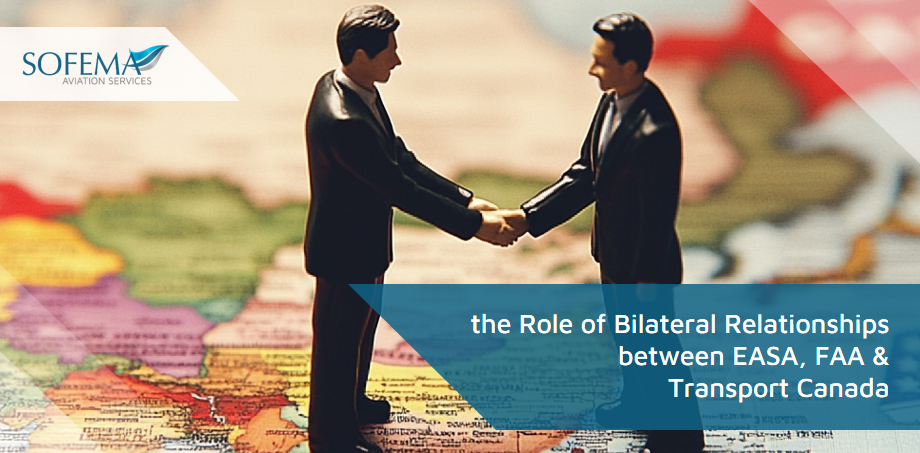Presented by Steve Bentley FRAeS CEO of Sofema Aviation Services (www.sassofia.com)
Introduction
The bilateral relationships between EASA (European Union Aviation Safety Agency), the FAA (Federal Aviation Administration, USA), and Transport Canada Civil Aviation (TCCA) are based on a framework of agreements and implementation procedures that allow for cooperation in airworthiness certification safety oversight, and maintenance. These agreements aim to streamline the certification processes, enhance safety, and reduce duplication of effort for the aviation industry in Europe, the United States, and Canada.
A key part of this framework includes the Technical Implementation Procedures (TIP) and the Maintenance Annex Guidance (MAG), which outline specific roles, processes, and responsibilities for how these agencies collaborate. Let’s explore the overall relationship while emphasizing the role of TIP and MAG.
The TIP outlines the shared responsibilities of the FAA and EASA in approving the design of products and articles eligible for import into each other’s jurisdictions. This agreement addresses the need for a more comprehensive approach to regulatory processes beyond just focusing on design, production, and exports. Historically, the FAA’s involvement in bilateral agreements has been managed by its Aircraft Certification Service, which states: “The U.S. only enters into Bilateral Aviation Safety Agreements with Implementation Procedures for Airworthiness with countries that have an established aircraft manufacturing industry and export products to the U.S.”
Bilateral Aviation Safety Agreements (BASA)
Each of these regulatory bodies has bilateral aviation safety agreements with one another, which provide the foundation for mutual recognition and cooperation:
- EASA-FAA BASA: Signed to simplify certification processes, this agreement allows each authority to rely on the other’s findings for airworthiness certification, environmental approval, and maintenance of civil aviation products. It covers areas such as:
- Design and production approval.
- Maintenance facilities oversight.
- EASA-Transport Canada BASA: This agreement establishes mutual recognition between Europe and Canada, facilitating the certification of aircraft, components, and maintenance organizations. The focus is on ensuring comparable safety standards and reducing regulatory burden.
- FAA-Transport Canada BASA: A similar arrangement exists between the FAA and Transport Canada, allowing for streamlined certification processes, including the approval of design and production standards for aircraft and aviation products, as well as maintenance facility approvals.
Mutual Recognition of Airworthiness
These agreements enable the mutual recognition of certifications* for aircraft design, production, and continued airworthiness. The key goal is to avoid redundant oversight and inspections while maintaining the highest safety standards.
* Note – To consider the Validation Process and how it works between the different jurisdictions
- Type Certification: When one authority certifies an aircraft, engine, or component as meeting its airworthiness standards, the others recognize that certification under the BASA agreement provided the product meets the importing authority’s specific conditions. (Note the Proviso)
- Environmental Standards: These agencies also coordinate environmental standards, particularly noise and emissions regulations, ensuring that certified products meet international environmental requirements.
Collaborative Oversight and Enforcement
EASA, the FAA, and Transport Canada coordinate oversight of aviation products, maintenance organizations, and operations, promoting safety while minimizing regulatory duplication.
- Maintenance Organizations: Mutual recognition of maintenance organizations between these authorities allows repair stations and maintenance facilities to operate more efficiently across regions. An organization certified in the U.S., for example, can maintain EASA-registered aircraft if they meet the necessary qualifications. (Again – Note the Proviso)
- Safety Data Sharing: The agencies share safety-related data, contributing to a global pool of knowledge on operational risks, technical problems, and accident prevention.
Certification and Validation Processes
Each authority conducts certification processes for aircraft, engines, and components under its regulations but agrees to accept the others’ findings, reducing the need for multiple, redundant certifications:
- Technical Validation: When one authority issues a certification, the other may perform a technical validation, reviewing the findings rather than starting a new certification from scratch. This expedites the approval process for manufacturers and operators.
- Production Certificates: Manufacturers that obtain production approval from one authority (e.g., FAA Production Certificate) can apply for validation by EASA or Transport Canada, enabling them to sell products in those markets with less administrative overhead.
Role of the Technical Implementation Procedures (TIP)
Technical Implementation Procedures Revision 7 Effective Nov 18th 2023, covering Design Approvals, Production Activities, Export – https://www.easa.europa.eu/en/downloads/138781/en (EASA- FAA).
Technical implementation procedures for airworthiness and environmental certification under the agreement on civil aviation safety between the Government of Canada And the European Union – Revision 4 10 December 2018 – (EASA – TCAA)
The Technical Implementation Procedures (TIP) are a critical supplement to BASA agreements and serve as a detailed guide for how EASA, FAA, and Transport Canada will implement and carry out the technical aspects of their bilateral agreements.
- Purpose of TIP: TIP provides a structured approach to how technical information is shared, how validation of products (such as aircraft, engines, and components) is conducted, and how safety oversight activities are coordinated. It lays out specific processes for validating type certificates and production certificates between agencies.
- How TIP Works:
- Type Certification: If one authority issues a type certificate for a new aircraft, the TIP defines how the other authority will validate and accept that certificate. This process ensures that safety standards are met while avoiding redundant certification efforts.
- Streamlining Validation: TIP allows for efficient validation procedures by recognizing the other authority’s certification work. For instance, a type certificate issued by the FAA can be accepted in Europe via EASA’s validation process, provided it meets the technical requirements outlined in TIP.
- Harmonization of Standards: TIP also helps harmonize technical standards between the three authorities, ensuring consistency in areas like safety, environmental compliance, and design approvals. This alignment is critical to facilitating international aviation commerce and safety oversight.
- TIP’s Role in Airworthiness: TIP ensures that once one agency certifies a product (aircraft, engine, or part), the others can validate and accept that certification, provided it meets the necessary technical criteria. This ensures airworthiness certification can be streamlined across borders.
Role of the Maintenance Annex Guidance (MAG)
EASA – FAA Maintenance Annex Guidance (MAG) Change 9 is Effective from October 8 2024
Change 9 to the U.S.-EU MAG introduces primarily clarifications and administrative updates, ensuring alignment with current standards, better-defining roles, and streamlining processes for both U.S.- and EU-based repair stations. – https://www.easa.europa.eu/en/downloads/140033/en
EASA – TCAA Maintenance Annex Guidance (MAG) Rev 3 – 11 July 2024
The Maintenance Annex Guidance (MAG) is another critical element of the bilateral relationships, focusing specifically on the oversight and mutual recognition of maintenance organizations.
- Purpose of MAG: The MAG provides the procedures for approving, overseeing, and inspecting aircraft maintenance organizations (MROs) that service aircraft registered under the jurisdiction of EASA, FAA, or Transport Canada. MAG ensures that maintenance performed on an aircraft in one region is recognized as valid in the other regions.
- How MAG Works:
- Approval of Maintenance Facilities: If an aircraft maintenance organization (AMO) is approved by one authority (e.g., FAA), it can be recognized by the others (e.g., EASA or Transport Canada) under MAG, provided that the AMO complies with the relevant maintenance standards and regulatory requirements.
- Standardized Procedures: MAG outlines standardized procedures for ensuring that maintenance organizations meet each authority’s respective safety and quality standards. It covers inspection processes, record-keeping, personnel certification, and tooling requirements.
- Reciprocal Oversight: The guidance allows for reciprocal oversight, meaning that an MRO approved in the U.S. under FAA rules can service EASA-registered aircraft, and vice versa, without needing a separate approval. This is vital for global airlines operating in multiple jurisdictions.
Mutual Recognition of Airworthiness
-
- Airworthiness Approvals, Post Design Approval Activities and Technical Support.
- MAG’s Role in Maintenance: MAG ensures that once an MRO is certified by one authority, it can perform work on aircraft from other regions without having to undergo additional certification processes. This simplifies the operation of global airlines and helps reduce costs.
Collaborative Oversight and Enforcement
EASA, FAA, and Transport Canada coordinate oversight of aviation products, maintenance organizations, and operations, ensuring safety while avoiding unnecessary duplication of efforts.
- TIP for Certification Processes: TIP plays a role in the collaborative certification of aircraft and components. By following the TIP, each authority can rely on the certification data and findings of the other, reducing the need for each authority to perform full certification processes for products already certified by one of the others.
- MAG for Maintenance: MAG ensures that maintenance oversight is coordinated between the agencies. This coordination involves regular inspections and compliance checks to ensure MROs adhere to required standards across regions.
Future Collaboration and Harmonization Efforts
The TIP and MAG continue to evolve as EASA, FAA, and Transport Canada work towards further harmonization of their regulatory frameworks, particularly in the face of new technologies and the growth of the global aviation market.
- Emerging Technologies: The TIP process is particularly important as new technologies, such as electric aircraft or unmanned aerial systems (UAS), emerge. These agencies will need to ensure that certification procedures are consistent and efficient across borders.
- Rulemaking Coordination: Ongoing collaboration is also vital to harmonizing regulations in areas like pilot training, aircraft performance standards, and environmental protection.
Conclusion
The bilateral relationships between EASA, FAA, and Transport Canada are strengthened by the Technical Implementation Procedures (TIP) and the Maintenance Annex Guidance (MAG), which provide detailed processes for implementing the overarching BASA agreements. These agreements, combined with TIP and MAG, facilitate mutual recognition of airworthiness certifications and maintenance standards, streamline regulatory processes, reduce industry costs, and enhance global aviation safety through coordinated oversight.
Next Steps
Follow this link to our Library to find & download related documents for Free.
Sofema Aviation Services (SAS) www.sassofia.com and Sofema Online (SOL) www.sofemaonline provide regulatory training related to Bilateral relationships between EASA – FAA – TCAA and UK CAA. Please see the websites or email team@sassofia.com.
Tags:
Aircraft Certification, Aviation MRO, Aviation Collaboration, Airworthiness Approval, Maintenance Annex Guidance, Aviation Oversight, Aviation Certification, Technical Implementation Procedures, global aviation, TIP, MAG, Bilateral Agreements, BASA, Aircraft Maintenance, Aviation Regulations, SAS blogs, Aviation safety training, TCCA, aircraft design, Maintenance Standards, Regulatory Compliance, FAA, Airworthiness, EASA, Aviation Training, aviation safety





